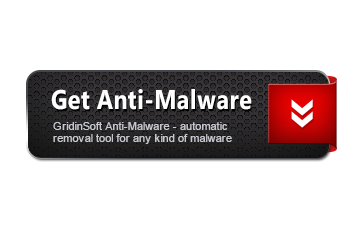The FakeAlert.12 is considered dangerous by lots of security experts. When this infection is active, you may notice unwanted processes in Task Manager list. In this case, it is adviced to scan your computer with GridinSoft Anti-Malware.

Gridinsoft Anti-Malware
Removing PC viruses manually may take hours and may damage your PC in the process. We recommend using GridinSoft Anti-Malware for virus removal. Allows to complete scan and cure your PC during the trial period.
What FakeAlert.12 virus can do?
- Behavioural detection: Executable code extraction – unpacking
- Performs HTTP requests potentially not found in PCAP.
- Reads data out of its own binary image
- CAPE extracted potentially suspicious content
- Drops a binary and executes it
- The binary likely contains encrypted or compressed data.
- Authenticode signature is invalid
- CAPE detected the embedded win api malware family
- Attempts to modify proxy settings
- Deletes executed files from disk
- Anomalous binary characteristics
- Yara detections observed in process dumps, payloads or dropped files
How to determine FakeAlert.12?
File Info:
name: 7543FD155BF54561D5D9.mlwpath: /opt/CAPEv2/storage/binaries/26ca301fd7f42c87b8dcc9908a05067c42c418fd40059c75429073ac0f206d0fcrc32: A53C7C2Cmd5: 7543fd155bf54561d5d9ec0a948e95d7sha1: 482df3ca3c9aa096b30dcf6b1a49addc7dcd98a2sha256: 26ca301fd7f42c87b8dcc9908a05067c42c418fd40059c75429073ac0f206d0fsha512: 0c250d203804c2b502f8e1db3b98fc8a9cfb213160984ab1019101c5f7e7deccc104873075197dc7bc935aec17a87a723605f4238509218add9df670b01c8956ssdeep: 6144:oswAhpeMSAjpVaBCxocmgPvvM42xD/CINy/McB6gwZmrSUflVdK0shRBpPgLVNF:oQSMSANkCx1mS3hKvcMwwZm+sLdK0IpQtype: PE32 executable (GUI) Intel 80386, for MS Windowstlsh: T1116412A2ED7B54DDD03023F1309AD3AC81F55D1A43D10EB835E2FA6763B86A219171BEsha3_384: 9c69320bdb8ade6a49c23748ecb9ac231c41e6adbfeee1e265998885f398e75b9e849a853b07438e167a6fb49ab87aabep_bytes: 558bec81c4dcfaffff568d742440c706timestamp: 1970-03-05 10:23:45Version Info:
0: [No Data]
FakeAlert.12 also known as:
| Bkav | W32.AIDetectMalware |
| AVG | Win32:FakeAV-BKP [Trj] |
| Elastic | malicious (high confidence) |
| DrWeb | Trojan.MulDrop25.27760 |
| MicroWorld-eScan | Gen:Variant.FakeAlert.12 |
| FireEye | Generic.mg.7543fd155bf54561 |
| CAT-QuickHeal | FraudTool.Security |
| Skyhigh | BehavesLike.Win32.VirRansom.fc |
| McAfee | Generic FakeAV.oi |
| Malwarebytes | Generic.Malware.AI.DDS |
| Zillya | Trojan.FakeAV.Win32.89801 |
| Sangfor | Suspicious.Win32.Save.a |
| K7AntiVirus | Trojan ( 001e60c61 ) |
| K7GW | Trojan ( 001e60c61 ) |
| CrowdStrike | win/malicious_confidence_100% (D) |
| BitDefenderTheta | Gen:NN.ZexaF.36802.tqW@aue17dni |
| Symantec | ML.Attribute.HighConfidence |
| tehtris | Generic.Malware |
| ESET-NOD32 | a variant of Win32/Kryptik.LYW |
| Cynet | Malicious (score: 100) |
| APEX | Malicious |
| ClamAV | Win.Trojan.FakeAV-5366 |
| Kaspersky | Trojan.Win32.FakeAV.btxt |
| BitDefender | Gen:Variant.FakeAlert.12 |
| NANO-Antivirus | Trojan.Win32.FakeAV.cqryh |
| SUPERAntiSpyware | Trojan.Agent/Gen-FakeSecurity |
| Avast | Win32:FakeAV-BKP [Trj] |
| Rising | Trojan.FakeAV!1.658F (CLASSIC) |
| Sophos | Mal/FakeAV-IS |
| F-Secure | Trojan.TR/FakeAV.btxt.8 |
| VIPRE | Gen:Variant.FakeAlert.12 |
| Trapmine | malicious.high.ml.score |
| Emsisoft | Gen:Variant.FakeAlert.12 (B) |
| SentinelOne | Static AI – Malicious PE |
| Jiangmin | Trojan/Fakeav.nbq |
| Avira | TR/FakeAV.btxt.8 |
| MAX | malware (ai score=86) |
| Antiy-AVL | Trojan/Win32.FakeAV |
| Kingsoft | malware.kb.a.1000 |
| Xcitium | TrojWare.Win32.Kryptik.LYW@31aarz |
| Arcabit | Trojan.FakeAlert.12 |
| ZoneAlarm | Trojan.Win32.FakeAV.btxt |
| GData | Gen:Variant.FakeAlert.12 |
| Varist | W32/FakeAlert.LY.gen!Eldorado |
| AhnLab-V3 | Trojan/Win32.Injector.R10921 |
| VBA32 | BScope.Trojan.MulDrop |
| ALYac | Gen:Variant.FakeAlert.12 |
| TACHYON | Trojan/W32.Agent.312320.BB |
| Cylance | unsafe |
| Panda | Trj/Cycbot.gen |
| Tencent | Trojan.Win32.FakeAV.ho |
| Yandex | Trojan.GenAsa!yy1Rj8Bfx+Y |
| Ikarus | Trojan.Win32.FakeAV |
| MaxSecure | Trojan.Malware.300983.susgen |
| Fortinet | W32/FakeAlert.AMB!tr |
| DeepInstinct | MALICIOUS |
| alibabacloud | Trojan.Win.UnkAgent |
How to remove FakeAlert.12?
- Download and install GridinSoft Anti-Malware.
- Open GridinSoft Anti-Malware and perform a “Standard scan“.
- “Move to quarantine” all items.
- Open “Tools” tab – Press “Reset Browser Settings“.
- Select proper browser and options – Click “Reset”.
- Restart your computer.



Leave a Comment